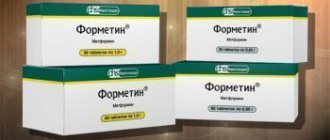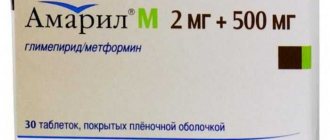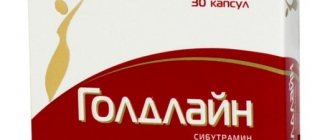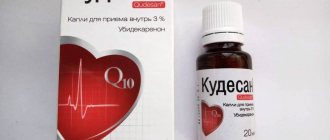Preductal® MR and OD is a drug that is often prescribed to people with problems with the cardiovascular system. It has antihypoxic and antioxidant effects and is used to prevent angina and ischemia. The drug Preductal® has received many positive reviews from customers and doctors. The article will discuss in detail the therapeutic properties of Preductal, its release form, composition and regimen for use by patients of various age groups.
Preductal is a drug for the treatment of pathologies of the cardiovascular system.
Medicine information
Preductal has a complex effect in the treatment of heart diseases. It is available in the form of tablets coated with a protective coating. The manufacturer offers several varieties of the product, depending on the dosage of the active ingredient:
- Preductal 35 or MR . The peculiarity of the product is the slow release of the active substance. This ensures a long-lasting therapeutic effect from taking the medication.
- Preductal 80 with an increased dosage of the active substance. The product is also characterized by a prolonged action. You only need to take the drug once a day.
Preductal 35 and 80 cannot be taken according to the same regimen. This is due to the different rates of absorption of the active components and its distribution throughout the tissues of the human body.
The medicine is produced in the French laboratory Serier. It is she who is responsible for the implementation of the product and its quality. The laboratory has several subsidiaries located in Ukraine and Poland. Medicines most often supplied to Russia are those produced in Poland at the Anpharm plant. The tablets are packaged in blisters already on the territory of our country.
Preductal tablets
According to the pharmacological classification, the drug Preductal belongs to antianginal drugs that improve the energy metabolism of the myocardium in conditions of ischemic disease of the cardiovascular system. The drug is prescribed by a doctor and is dispensed strictly according to the prescription. The active ingredient of the composition is trimetazidine dihydrochloride, which has the function of normalizing the transport of potassium and sodium ions.
Compound
Preductal is available only in the form of modified-release tablets. They are covered with a pink film shell and white inside. The shape is round, biconvex, in a package of 60 pieces in a blister. Composition of the drug:
| Concentration of trimetazidine dihydrochloride, mg per 1 piece. | 35 |
| Additional composition | Povidone, magnesium stearate, calcium hydrogen phosphate dihydrate, hypromellose, macrogol, colloidal silicon dioxide |
| Shell components | Titanium dioxide, iron oxide red, magnesium stearate, hypromellose, macrogol, glycerol |
How the drug works
The active substance of the drug acts selectively, preventing a decrease in intracellular adenosine triphosphate (ATP) by maintaining the energy metabolism of cells in a state of hypoxia (without access of oxygen to the brain tissue). This ensures the normal functioning of membrane channels, the transfer of potassium and sodium ions, and the preservation of cell homeostasis. When using trimetazidine, the rate of fatty acid oxidation decreases.
The substance inhibits some enzymes, which increases the rate of glucose oxidation and accelerates glycolysis. This protects the myocardium from ischemic damage. According to research, trimetazidine has the following properties:
- supports the metabolism of the myocardium of the heart;
- reduces the severity of intracellular acidosis;
- reduces the level of neutrophil migration in heart tissues;
- reduces the area of myocardial damage;
- protects the myocardium from revascularization;
- does not affect hemodynamic parameters;
- increases coronary reserve with symptoms of angina pectoris;
- prevents pressure from fluctuating sharply;
- reduces the frequency of angina attacks and the need for nitroglycerin;
- increases the contractile function of the left ventricle, normalizes the beating rhythm;
- expands the perceived sound range in case of perceptual deafness.
After oral administration, trimetazidine is rapidly adsorbed, reaching maximum concentration after five hours. Throughout the day, the concentration of the active substance Preductal in plasma remains at the proper level . Food intake does not affect the bioavailability of the drug. The substance binds 16% to plasma proteins and is excreted unchanged by the kidneys. The half-life in young people is 7 hours, over 65 years - 12. In people over 75 years of age, the elimination time may increase due to age-related decline in kidney function.
Article on the topic: Vegetative crisis (panic attack) - the first symptoms and treatment of a patient in this condition
Indications for use
The instructions for the drug Preductal state that the indications for its use are the following diseases:
- coronary heart disease (as part of long-term therapy for heart failure);
- prevention of attacks of stable angina (as a component of monotherapy or as part of combination treatment);
- prevention of the development of ischemic damage to the myocardium.
pharmachologic effect
The active component of the drug Preductal MR and OD is trimetazidine. As a result of the research, the following therapeutic properties of the substance were revealed:
- reduction of the lumen of the affected myocardium;
- support of energy metabolism of heart tissue;
- reduction in the severity of symptoms characteristic of ischemia;
- slowing down the development of ischemia when performing complex physical activities;
- reduction in the frequency of angina attacks;
- limiting blood pressure fluctuations when performing physical activity;
- improvement of contractile function of the left ventricle.
For angina pectoris, Preductal tablets can be used as monotherapy and as part of complex treatment.
Pharmacological properties
Pharmacological action - improves energy metabolism, antihypoxic.
Pharmacodynamics
Trimetazidine prevents a decrease in intracellular adenosine triphosphate (ATP) concentration by maintaining the energy metabolism of cells in a state of hypoxia. Thus, the drug ensures the normal functioning of membrane ion channels, transmembrane transport of potassium and sodium ions and the preservation of cellular homeostasis.
Trimetazidine inhibits the oxidation of fatty acids due to the selective inhibition of the enzyme 3-ketoacyl-CoA-thiolase (3-KAT) of the mitochondrial long-chain isoform of fatty acids, which leads to increased glucose oxidation and acceleration of glycolysis with glucose oxidation, which determines myocardial protection from ischemia.
The switch of energy metabolism from fatty acid oxidation to glucose oxidation underlies the pharmacological properties of trimetazidine.
It has been experimentally confirmed that trimetazidine has the following properties:
- supports energy metabolism of the heart and neurosensory tissues during ischemia;
- reduces the severity of intracellular acidosis and changes in transmembrane ion flow that occur during ischemia;
- reduces the level of migration and infiltration of polynuclear neutrophils in ischemic and reperfused heart tissues;
- reduces the size of myocardial damage;
- does not have a direct effect on hemodynamic parameters.
In patients with angina, trimetazidine:
- increases coronary reserve, thereby slowing down the onset of ischemia caused by physical activity, starting from the 15th day of therapy;
- limits exercise-induced blood pressure fluctuations without significant changes in heart rate;
- significantly reduces the frequency of angina attacks and the need for short-acting nitroglycerin;
- improves contractile function of the left ventricle in patients with ischemic dysfunction.
The results of clinical studies have confirmed the effectiveness and safety of trimetazidine in patients with stable angina, both in monotherapy and as part of combination therapy when the effect of other antianginal drugs is insufficient.
In a randomized, double-blind, placebo-controlled trial of 426 patients with stable angina (TRIMPOL-II), trimetazidine (60 mg daily) was added to metoprolol 100 mg daily (50 mg twice daily) for 12 weeks. statistically significantly improved exercise test results and clinical symptoms compared to placebo:
- the total duration of the load tests was +20.1 s; p = 0.023,
- total load execution time +0.54 METs; p=0.001,
- time to development of ST segment depression by 1 mm +33.4 s; p = 0.003,
- time to development of angina attack +33.9 s, p < 0.001,
- number of angina attacks per week -0.73; p=0.014
- consumption of short-acting nitrates per week -0.63; p = 0.032, without hemodynamic changes.
In a randomized, double-blind, placebo-controlled study of 223 patients with stable angina (Sellier), the addition of trimetazidine 35 mg twice daily to atenolol 50 mg once daily for 8 weeks resulted in an increase in the time to the development of ischemic depression of the ST segment by 1 mm (+34.4 s; p = 0.03) during stress tests in a subgroup of patients (n = 173), compared with placebo, 12 hours after taking the drug. This difference was also shown for the time of development of angina attacks (p = 0.049). There were no significant differences between groups for other secondary endpoints (total exercise test duration, total exercise time, and clinical endpoints).
In a three-month randomized, double-blind study of 1962 patients with stable angina (Vasco), trimetazidine at two doses (70 mg daily and 140 mg daily) versus placebo was added to therapy with atenolol 50 mg daily. In the general population, including patients with both asymptomatic and symptomatic angina, trimetazidine did not demonstrate benefit on ergometric (total duration of exercise tests, time to ischemic ST-segment depression of 1 mm, and time to onset of angina) and clinical endpoints. . However, in a retrospective analysis in a subgroup of patients with symptomatic angina (n = 1574), trimetazidine (140 mg) significantly improved total exercise test time (+23.8 s versus +13.1 s for placebo; p = 0.001) and time to development angina attack (+46.3 s, compared with +32.5 for placebo; p = 0.005).
Pharmacokinetics
Absorption. After oral administration, trimetazidine is rapidly absorbed and reaches maximum plasma concentrations after approximately 5 hours.
Over 24 hours, the concentration in the blood plasma remains at a level exceeding 75% of the concentration determined after 11 hours. The equilibrium state is reached after 60 hours. Food intake does not affect the bioavailability of trimetazidine.
Distribution. The volume of distribution is 4.8 l/kg, which indicates good distribution of trimetazidine in tissues (the degree of binding to plasma proteins is quite low, about 16% in vitro).
Excretion. Trimetazidine is excreted mainly by the kidneys, mainly unchanged. The half-life in young healthy volunteers is about 7 hours, in patients over 65 years of age - about 12 hours. Renal clearance of trimetazidine directly correlates with creatinine clearance (CC), hepatic clearance decreases with patient age.
Special groups. Patients over 75 years of age. Patients over 75 years of age may experience increased exposure to trimetazidine due to age-related decline in renal function. A special study was conducted in a population of patients over 75 years of age while taking trimetazidine tablets 35 mg 2 times a day. An analysis performed by a kinetic population method showed an average twofold increase in plasma exposure in patients with severe renal failure (creatinine clearance less than 30 ml/min) compared with patients with creatinine clearance greater than 60 ml per minute.
No safety differences were found in patients over 75 years of age compared with the general population.
Patients with renal failure. Trimetazidine exposure was increased on average by 2.4 times in patients with moderate renal failure (creatinine clearance 30–60 ml per minute), and on average by 4 times in patients with severe renal failure (creatinine clearance less than 30 ml per minute). minute) compared to healthy volunteers with normal kidney function.
No significant safety differences were observed in this patient population compared with the general population.
Use in children and adolescents. The pharmacokinetics of trimetazidine in children and adolescents under 18 years of age have not been studied.
Composition and release forms
The drug Preductal® MR and OD is presented on the pharmacological market in the form of biconvex red tablets. The active substance, trimetazidine dihydrochloride, is contained in each pill in a dosage of 20 mg. Among the active substances of the drug it should be noted:
- povidone;
- silicon dioxide and titanium;
- macrogol-6000;
- red oxidizing agent;
- glycerol;
- calcium hydrogen phosphate
Preductal® OD extended release capsules
hard gelatin, No. 2, with a white body and an orange-red lid; the company logo and the inscription “80” in white* are printed on the lid; The contents of the capsule are spherical granules of white or almost white color.
| Main active ingredient: | In 1 capsule |
| trimetazidine dihydrochloride (granules) | 80 mg. |
# trimetazidine dihydrochloride, granule substance (film-coated granules) – 144.85 mg.
Excipients in the capsules:
sugar spheres (710-850 microns), hypromellose.
Composition of the capsule film shell:
ethylcellulose, tributylacetyl citrate, talc.
Composition of the mixture for powdering granules:
talc, magnesium stearate.
Hard gelatin capsule No. 2 with a white body and an orange-red cap, the company logo and the inscription “80” are printed on the cap in white.
Composition of the capsule body:
titanium dioxide (E171), gelatin.
Capsule cap composition:
titanium dioxide (E171), red iron oxide (E172), gelatin.
9 or 10 pcs. – blisters (3 or 6 pcs) – cardboard packs.
Clinical and pharmacological group of the drug : Antianginal drug.
Pharmacotherapeutic group of the drug : Antianginal agent.
Indications and contraindications for use
Preductal is prescribed for the treatment of angina and other cardiac pathologies.
The main indication for use of the product is to improve metabolism in the tissues of the cardiovascular system. In rare cases, the drug Preductal® is used as part of a complex treatment of ENT diseases and ophthalmological disorders.
Other indications for the use of Preductal capsules include:
- long-term therapy of ischemic disease;
- complex treatment or monotherapy of angina pectoris;
- elimination of cochleo-vestibular disorders (dizziness, extraneous tinnitus);
- chorioretinal disorders with an ischemic component.
It is prohibited to take the medicine under 18 years of age. Pregnancy and breastfeeding are also contraindications for the use of Preductal capsules. This limitation is due to insufficient knowledge of the effect of trimetazidinane dihydrochloride on the body of lactating and pregnant women. Another contraindication to treatment with Preductal is renal failure and individual sensitivity to the components of the drug.
Instructions for use
It is recommended to swallow tablets (Preductal® capsules) whole, without crushing them into powder or chewing them. You can take the pills with clean still water. It is advisable to take the drug with meals.
For adults, the drug is usually prescribed 1 tablet 2-3 times a day. The duration of therapy can be up to 3 months. The duration of treatment is determined for each individual patient separately and depends on the severity of the disease.
The maximum daily dosage of the drug is 60 mg or 3 tablets. Exceeding the established standards threatens the development of side effects for the body.
Preductal should be prescribed with caution to patients with renal failure. In this case, the dosage of the drug will be determined depending on the creatinine clearance. If the reading is above 60 ml/min, Preductal is prescribed in standard dosages. If the creatinine level is less than 60 ml/min, then the number of tablets taken is reduced by 2 times: to 1-2 capsules per day. In this case, one pill is taken in the morning, and the second in the evening. During treatment, creatinine clearance is monitored every week and, if necessary, the dosage of the drug is adjusted.
Dosage and method of administration
The instructions for use indicate that the tablets should be taken orally whole, without chewing and with water.
- Preductal MV is prescribed 1 tablet. 2 times/day during meals in the morning and evening. The maximum daily dose is 70 mg. The duration of treatment is determined by the doctor.
Patients over 75 years of age may experience increased trimetazidine exposure due to age-related decline in renal function. The dose should be selected with caution.
In patients with moderate renal failure (creatinine clearance 30-60 ml/min), the daily dose is 35 mg (1 tablet). The tablets should be taken in the morning, during breakfast.
Side effects from therapy
In most cases, Preductal capsules are well tolerated by patients. Side effects from treatment may occur if the patient does not comply with the indicated dosages or ignores contraindications. Negative reactions during drug treatment manifest themselves in the form of:
- headaches of various localizations;
- hives;
- itching of the skin;
- lowering blood pressure;
- constant dizziness;
Dizziness may occur when taking Preductal.
- muscle tone disorders;
- dyspeptic disorders.
If these symptoms appear, you should stop taking Preductal and consult your doctor. Usually, side effects from the drug disappear on their own 2-3 days after discontinuation of therapy.
special instructions
Let's look at the list of special recommendations when treating with Preductal MR or Preductal OD capsules:
- If angina attacks become more frequent, the treatment regimen is adjusted with the doctor’s permission.
- The drug is not used for the treatment of angina attacks and myocardial infarction.
- After using the drug, the course of parkinsonism may worsen. The pathology can be supplemented by hand tremors and increased muscle tone. Elderly patients should be observed by a neurologist while taking Preductal.
- Drug therapy is discontinued in case of respiratory problems, gait instability and hand tremors. These symptoms usually disappear completely in patients 4 months after the end of therapy. If signs of parkinsonism bother a person for more than 4 months, then he needs to register with a neurologist.
- With the use of Preductal MR and OD capsules, instability in the Romberg position may occur. The condition is complemented by unsteadiness of gait and low blood pressure. Symptoms appear especially clearly when Preductal and antihypertensive drugs are taken together.
Important! The medication should be used with caution in case of renal and liver failure, and in old age (over 75 years).
Preductal tablets may affect your ability to drive. During therapy, it is advisable to refrain from driving a car and work associated with increased concentration.
Preductal
pharmachologic effect
Preductal® MB prevents a decrease in intracellular ATP content by maintaining the energy metabolism of cells in a state of hypoxia.
Thus, the drug ensures the normal functioning of membrane ion channels, transmembrane transport of potassium and sodium ions and the preservation of cellular homeostasis. Trimetazidine slows down the oxidation of fatty acids due to the selective inhibition of long-chain 3-ketoacetyl-CoA thiolase, which leads to increased glucose oxidation and restoration of the coupling between glycolysis and oxidative decarboxylation and protects the myocardium from ischemia. The switch from fatty acid oxidation to glucose oxidation underlies the antianginal effect of trimetazidine.
It has been experimentally confirmed that trimetazidine has the following properties:
— supports the energy metabolism of the heart and neurosensory organs during ischemia;
- reduces the amount of intracellular acidosis and the degree of changes in the transmembrane ion flow that occurs during ischemia;
- reduces the level of migration and infiltration of polynuclear neutrophils in ischemic and reperfusion tissues of the heart;
- reduces the size of myocardial damage;
- does not have a direct effect on hemodynamic parameters.
In patients suffering from angina, trimetazidine:
— increases coronary reserve, thereby slowing down the development of ischemia caused by physical activity, starting from the 15th day of therapy;
- limits sharp fluctuations in blood pressure caused by physical activity, without any significant changes in heart rate;
- significantly reduces the frequency of angina attacks and the need for short-acting nitroglycerin;
— improves the contractile function of the left ventricle in patients with ischemic dysfunction.
In clinical studies lasting 2 months, it was shown that the addition of Preductal® MB at a dose of 35 mg to therapy with atenolol at a dose of 50 mg after 12 hours led to a significant slowdown in the onset of ischemic depression of the ST segment during stress tests.
Pharmacokinetics
Suction
After taking the drug orally, trimetazidine is rapidly absorbed. Cmax is reached after 5 hours. For more than 24 hours, the plasma concentration remains at a level exceeding 75% of the concentration determined after 11 hours. Food intake does not affect the pharmacokinetic properties of the drug.
Distribution
Css is achieved after 60 hours. Vd is 4.8 l/kg, which indicates good distribution of trimetazidine in tissues.
Plasma protein binding is low, about 16% (in vitro).
Removal
It is excreted from the body mainly by the kidneys unchanged. T1/2 - about 7 hours, in patients over 65 years old - about 12 hours.
Renal clearance of trimetazidine directly correlates with creatinine clearance; hepatic clearance decreases with age.
It has been shown that in elderly patients with a daily dose of 2 tablets. in 2 doses, increasing plasma exposure does not lead to any significant effects compared to placebo.
Indications
- long-term therapy of coronary artery disease: prevention of attacks of stable angina pectoris in the form of monotherapy or as part of combination therapy.
Dosage regimen
Preductal® MB is prescribed 1 tablet. 2 times/day during meals in the morning and evening. The duration of therapy is determined individually.
I take the tablets whole orally, without chewing and with water.
Side effect
Adverse reactions, defined as adverse events at least possibly related to treatment with trimetazidine, are listed in the following gradation: very often (≥1/10); often (≥1/100, <1/10); uncommon (≥1/1000, <1/100); rare (≥1/10,000, <1/1000); very rare (<1/10,000), unspecified frequency (frequency cannot be calculated from available data).
From the digestive system:
often - abdominal pain, diarrhea, dyspepsia, nausea, vomiting; unspecified frequency - constipation.
From the side of the central nervous system:
often - dizziness, headache; unspecified frequency - extrapyramidal symptoms (tremor, rigidity, akinesia, instability in the Romberg position and “wobbly” gait), especially in patients with Parkinson’s disease, reversible after discontinuation of the drug; unspecified frequency - sleep disturbances (insomnia, drowsiness).
For the skin and subcutaneous fat:
often - skin rash, itching, urticaria; unspecified frequency - acute generalized exanthematous pustulosis, Quincke's edema.
From the cardiovascular system:
rarely - a feeling of palpitations, extrasystole, tachycardia, a marked decrease in blood pressure, orthostatic hypotension, which may be accompanied by general weakness, dizziness or loss of balance, especially when taking antihypertensive drugs, “flushes” of blood to the skin of the face.
From the hematopoietic system:
unspecified frequency - agranulocytosis, thrombocytopenia, thrombocytopenic purpura.
From the liver and biliary tract:
unspecified frequency - hepatitis.
General violations:
often - asthenia.
Contraindications
— severe renal failure (creatinine clearance less than 30 ml/min);
- Parkinson's disease, symptoms of parkinsonism, tremor, restless legs syndrome and other associated movement disorders;
- hypersensitivity to the components of the drug.
Due to the lack of sufficient clinical data, it is not recommended to prescribe the drug to children and adolescents under the age of 18 years.
Carefully _
the drug should be prescribed to patients with severe liver failure (clinical data are limited), patients with moderate renal failure.
Pregnancy and lactation
There are no data on the use of Preductal® MB in pregnant women.
Animal studies have not shown any direct or indirect reproductive toxicity.
Reproductive toxicity studies have shown no effect of trimetazidine on reproductive function in rats of either sex.
As a precautionary measure, it is not recommended to use Preductal® MB during pregnancy.
There are no data on the excretion of trimetazidine or its metabolites into breast milk. Risk to the newborn/child cannot be excluded. Preductal® MB should not be used during breastfeeding.
special instructions
It should be borne in mind that Preductal® MV is not intended for the relief of attacks of angina pectoris or myocardial infarction at the prehospital stage or in the first days of hospitalization.
If an attack of angina occurs, treatment (drug therapy or revascularization) should be reviewed and adapted.
Preductal® MB may cause or worsen symptoms of parkinsonism (tremor, akinesia, increased tone), so patients should be regularly monitored, especially the elderly. In doubtful cases, patients should be referred to a neurologist for appropriate examination.
If movement disorders appear, such as symptoms of parkinsonism, restless legs syndrome, tremor, instability in the Romberg position and unsteadiness of gait, Preductal® MB should be permanently discontinued.
Such cases are rare and symptoms usually resolve after discontinuation of therapy: in most patients, within 4 months after discontinuation of the drug. If symptoms of parkinsonism persist more than 4 months after discontinuation of the drug, you should consult a neurologist.
There may be cases of falls associated with instability in the Romberg position and “wobbly” gait or a pronounced decrease in blood pressure, especially in patients taking antihypertensive drugs.
Preductal® MB should be prescribed with caution to patients in whom increased exposure may occur:
- with moderate renal failure;
- in elderly patients over 75 years of age.
Impact on the ability to drive vehicles and operate machinery
During clinical studies, no effect of the drug Preductal® MB on hemodynamic parameters was revealed, however, during the period of post-registration use, cases of dizziness and drowsiness were observed, which may affect the ability to drive vehicles and perform work that requires an increased speed of physical and mental reactions.
Overdose
There is limited information about trimetazidine overdose.
In case of overdose, symptomatic therapy is carried out.
Drug interactions
Drug interactions with Preductal® MB have not been described.
Conditions for dispensing from pharmacies
The drug is available with a doctor's prescription.
Storage conditions and periods
No special storage conditions are required. Keep out of the reach of children. Shelf life: 3 years. Do not use after the expiration date stated on the package.
Analogues of Preductal®
Structural analogues of Preductal MR and OD capsules include Cardimax. The latest medication can completely replace the original in the treatment of angina and ischemia. Among the non-structural analogues of Preductal, the following should be highlighted:
- ATP-long . The active substance in the drug is adenosine triphosphoric acid. Indications for use of ATP-long: unstable angina, chronic fatigue syndrome, heart rhythm disturbances, cardiosclerosis, coronary heart disease. The product has many restrictions on use and side effects, so it is not suitable for independent use.
- Bravadin . The main indication for use of the drug is to reduce heart rate. The active component of the drug is ivabradine. The medicine has antianginal and anti-ischemic effects. The medicine is used to eliminate signs of chronic fatigue and stable angina.
- Mildronate . Improves metabolic processes in the myocardium and has a positive effect on the cardiovascular system as a whole. The drug is often prescribed for the treatment of fundus dystrophy. Indications for the use of Mildronate: retinopathy, venous thrombosis, heart failure, poor exercise tolerance.
Mildronate is a non-structural analogue of Preductal.
The average cost of Preductal is 900 rubles . The price of analogues varies between 660 -1760 rubles .
Interesting fact! Preductal and Preductal MB differ in the rate of release of the active substance. In the latter case, the process occurs more slowly due to a special production technology. For this reason, Preductal MB should be taken less often than the original. There are no other differences between the medications.












